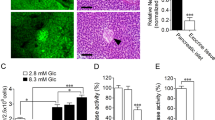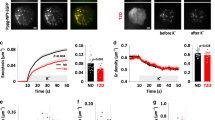Abstract
ALTHOUGH glucose was for a long time considered the most important physiological agent for stimulating release of the insulin from the islets of Langerhans, there have recently been reports that the five carbon polyhydric alcohol xylitol is also active in causing insulin secretion, either in whole animals1 or in perfused pancreas preparations2. The substance is believed to be metabolized in mammalian tissues through the pentose phosphate pathway3. Because this pathway seems to be important in the release of insulin4,5, the effects of pentitols and pentoses on insulin secretion have been examined in greater detail, using isolated rat islets of Langerhans.
This is a preview of subscription content, access via your institution
Access options
Subscribe to this journal
Receive 51 print issues and online access
$199.00 per year
only $3.90 per issue
Buy this article
- Purchase on Springer Link
- Instant access to full article PDF
Prices may be subject to local taxes which are calculated during checkout
Similar content being viewed by others
References
Hirata, Y., Fujisawa, M., Sato, H., Asano, T., and Katsuki, S., Biochem. Biophys. Res. Commun., 24, 471 (1966).
Kuzuya, T., Kanazawa, Y., and Kosaka, K., Metabolism, I5, 1149 (1966).
Touster, O., and Shaw, D. R. D., Physiol. Rev., 42, 181 (1962).
Field, J. B., Johnson, P., Herring, B., and Weinberg, A. N., Nature, 185, 468 (1960).
Lazarow, A., Dixit, P. K., Lindall, A., Moran, J., Hostetler, K., and Cooperstein, S. J., The Structure and Metabolism of the Pancreatic Islets (edit. by Brolin, S. E., Hellman, B., and Knutson, H.), 249 (Pergamon, London, 1964).
Lacy, P. E., and Kostianovsky, M., Diabetes, 16, 35 (1967).
Howell, S. L., and Taylor, K. W., Biochim. Biophys. Acta, 130, 519 (1966).
Hales, C. N., and Randle, P. J., Biochem. J., 88, 137 (1963).
Montague, W., Howell, S. L., and Taylor, K. W., Diabetologia (in the press, 1967).
Porte, jun., D., and Williams, R. H., Science, 152, 1248 (1966).
Coore, H. G., and Randle, P. J., Biochem. J., 93, 66 (1964).
Wick, A. N., Drury, D. R., Nakada, H. I., and Wolfe, J. B., J. Biol. Chem., 224, 963 (1957).
Barban, S., Fed. Proc., 19, 385 (1960).
Lambert, A. E., Jeanrenaud, B., and Renold, A. E., Lancet, i, 819 (1967).
Turtle, J. R., Littleton, G. K., and Kipnis, D. M., Nature, 213, 727 (1967).
Author information
Authors and Affiliations
Rights and permissions
About this article
Cite this article
MONTAGUE, W., HOWELL, S. & TAYLOR, K. Pentitols and the Mechanism of Insulin Release. Nature 215, 1088–1089 (1967). https://doi.org/10.1038/2151088a0
Received:
Issue Date:
DOI: https://doi.org/10.1038/2151088a0
This article is cited by
-
Enzymehistochemical studies on the pancreatic islets in mice injected with anti-insulin serum
Diabetologia (1972)
-
The behaviour of the serum insulin level in non obese adult diabetics after intravenous glucose, tolbutamide and glucagon
Acta Diabetologica Latina (1970)
-
Metabolic control of insulin secretion
Acta Diabetologica Latina (1970)
-
Attualità dello xilitolo
Acta Diabetologica Latina (1970)
-
Stimulation of Insulin Secretion in the Rabbit by D-Ribose
Nature (1969)
Comments
By submitting a comment you agree to abide by our Terms and Community Guidelines. If you find something abusive or that does not comply with our terms or guidelines please flag it as inappropriate.



